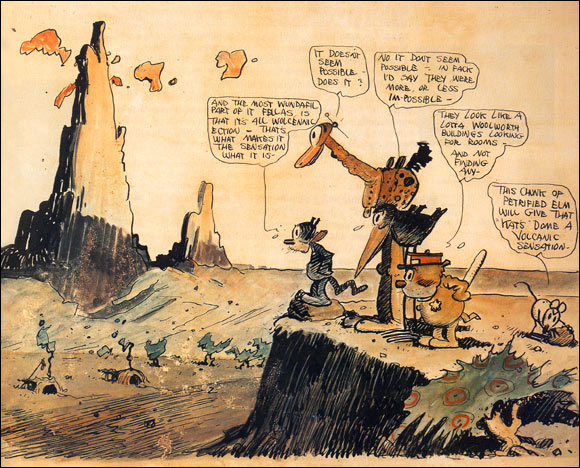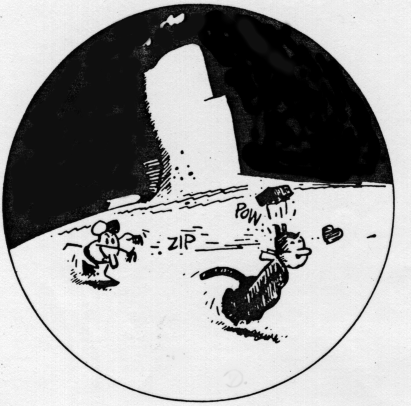A cat. A dog. A mouse. A brick.
From such simple materials George Herriman, a true genius of 20th-century art, fashioned a world of wacky and winsome wonders!
In case you are one of the blissfully uninformed who has yet to discover this multifarious and mystifying realm, I am talking about the delightful and hilarious comic strip Krazy Kat, which ran daily in newspapers from 1913 to 1944.
The dramatic structure and conflicts of the strip are easily summarized: Krazy, a cat (or "Ket" in Krazy's own unique argot) sings, dances and ambles through the world with one thing in mind: he or she (more on this later!) is hopelessly in love with character #2, Ignatz Mouse. Ignatz, a cynical iconoclast, does not return Krazy's affection. What he does return--and deliver--at every opportunity, are bricks, calculated to crease Krazy's benevolent, adoring noggin. Krazy knows these masonic missles are adamantine tokens of Ignatz' love, and welcomes them as such. To complete the eternal triangle enter The Law: Offisa Bull Pupp. Pupp's job is to stop Ignatz from firing his bricks at Krazy. Pupp is secretly in love with Krazy himself. Krazy seems unaware of his affection. Krazy just knows that Offisa Pupp frequently lodges her or his unrequited lover in the local jail. Sometimes Krazy even works to release Ignatz from these confines, consternating the cop.
[A quick note about the strip's seeming pronominal confusion and Krazy's gender is in order: the strip sometimes refers to the self-described "Heppy Ket" as he/his, sometimes as she/her. When film director Frank Capra asked Herriman to clear up the issue of Krazy's gender, the cartoonist replied that, after his own soul-searching and experimentation with the character, he realized that "Krazy was something like a sprite, an elf. They have no
sex. So that Kat can't be a ‘he’ or a ‘she.’ The Kat's a sprite—a
pixie—free to butt into anything. Don't you think so?" This article will treat him or her accordingly.]
And so it goes. Eternally, under the surreal sun or wacky moon or sometimes moons of stylized Coconino County. Kat loves Mouse. Mouse hates Kat, expressing it with impenetrable projectiles. Dog cop loves Kat and incarcerates Mouse incessantly.
It is a formula so simple as to be iconic and eternal.
What George Herriman did within the confines of such a simple plot is truly and delightfully miraculous.
[Click to Enlarge]
The action of Krazy Kat is set in a wildly stylized version of the real Coconino County, Arizona, the country's second-largest county and home to natural wonders like the Grand Canyon and the Painted Desert. These landforms, through the lens of Herriman's imagination, show up as bizarre and surreal backgrounds to the strip, ever-changing and fascinating.
Herriman's strip is the perfect blend of exuberantly imaginative visuals, inventive plotting, and idiosyncratic, slangy, alliterative dialogue. Krazy speaks in a strange dialect, said by some to be a version of Yat, the New Orleans dialect that Herriman himself grew up speaking. (Krazy: “Lenguage is that we may mis-unda-stend each udda.”) The dialogue in the strip is sometimes phonetically spelled and ranges from Krazy's unique mixture, sprinkled with Yiddishisms, to the mock-intellectual, wryly poetic pronouncements and descriptions of the strip's narrator ("Officer Pupp, engaged in small talk with 'Krazy Kat,' of this, of that, and why - why is Red Mesa red, and White Mesa white, and why is Black Mesa black - and is it true that the mountains of 'Kaibito' lie down to let the sand dunes crawl over them, and are the Elephant's Feet pink because they wade in Red Lake - --------------- when, alluvasudden -") [Note: It looks so much better in Herriman's printed all caps! See original here. - Herm.]
 Herriman spun off the Kat-mouse-and-dog eternal triangle from an earlier strip of his called The Dingbat Family, which debuted in 1910. Said family was mostly concerned about the noisy hubbub of the never-seen people who lived upstairs. Just as Popeye appeared first as a walk-on sailor in Elzie Segar's strip Thimble Theatre, Krazy and Ignatz first appeared as a cat-and-mouse gag drawn at the bottom of The Dingbat Family panels: Ignatz was the upstairs family's mouse come down to variously antagonize and annoy the Dingbats' cat. It was Ignatz who described the cat as 'Krazy.'
Herriman spun off the Kat-mouse-and-dog eternal triangle from an earlier strip of his called The Dingbat Family, which debuted in 1910. Said family was mostly concerned about the noisy hubbub of the never-seen people who lived upstairs. Just as Popeye appeared first as a walk-on sailor in Elzie Segar's strip Thimble Theatre, Krazy and Ignatz first appeared as a cat-and-mouse gag drawn at the bottom of The Dingbat Family panels: Ignatz was the upstairs family's mouse come down to variously antagonize and annoy the Dingbats' cat. It was Ignatz who described the cat as 'Krazy.'
As these things do, the bottom-of-panel slapstick gag grew by 1913 to be its own, now-titled strip, which, of course, eventually replaced The Dingbat Family.
But it was back in 1910, when the cat and the mouse were still just an afterthought doodle at the bottom of the larger strip, that the historic event took place: on July 26 of that year, the mouse first threw a brick at the head of the cat!
We commemorate this important happening in our cultural history: 101 years ago within hours of this publishment.
While the strip met a sometimes puzzled, mixed reception by the public in the 30 years of its daily run, it was then and has since been embraced by intellectuals and artists of all kinds. The art critic Gilbert Seldes called it "the most amusing and fantastic and satisfactory work of art produced in America today." Poet e.e. cummings wrote a now-famous essay about the strip as the introduction of the first collection of Krazy Kat in book form. In its time, other big fans of the strip included Willem de Kooning, H.L. Mencken, and Jack Kerouac.
One of the strip's biggest admirers was William Randolph Hearst, in whose New York Evening Journal it first appeared. Hearst so loved the strip that he gave Herriman a lifetime contract and nearly-complete creative freedom. We can thank Citizen Hearst for providing an open platform for George Herriman's fertile and wacky imagination.
Since then, the strip has been admired by millions, has been converted into several series of (mostly terrible) animated cartoons, has inspired a jazz ballet (1922) and has influenced many well-known cartoonists, from Charles Schultz and Will Eisner to Patrick McDonnell (Mutts) and, to me most obviously, Bill Watterson's brilliant Calvin and Hobbes.
And so I welcome you to the visual and verbal joys of one of America's great works of art! If you have never seen Krazy Kat before, you can read more about it here, and explore some galleries of strips here.
Welcome to Coconino County and the joys of Krazy Kat!
[Click to Enlarge]





A subject near and dear to the hearts of those of us who lobby for comics' inclusion in the history of American "cultcha". This is a concise and word-perfect rendition of a complex literary/visual poetry, Jim.
ReplyDeleteMore: a recent addition to the bargain bins at Tattered Cover bookstore is a catalog from a LACMA/Hammer Museum exhibition, "Masters of American Comics", which features commentary on Krazy Kat by John Carlin and Stanley Crouch, as well as perspective on how much influence Herriman, Feininger, McCay, etc had on later comic artists, not to mention other media.
Thanks for the words, hggns. I do love the 'Kat.'
ReplyDeleteSuch a creation stand on the same level with any or most in American culture that can be called 'great.'
Which is better: Whitman's "Song of Myself" or the collected Herriman ouvre?
It is a brick tossup.
A more apt comparison would be that very similar soul, e.e. cummings. He knew it, too, when he took up pen to write his essay on Krazy and Ignatz. There is a similar playful energy going on there, the transformation of basics to the exquisitely wacky. Cummings is underrated these days.
Or very possibly Thelonius Monk. Put him and Herriman side by side, arm in arm.
There is, indeed, much of jazz in Herriman.
Who else?
Comments welcome.
Werra, werra well said.
ReplyDeleteI'm certainly glad Every Book And Cranny sent me a link to your post.
I discovered Herriman a little over a year ago and that quickly sparked an addiction to early newspaper comic strips.
I've been writing about similar subjects on my blog. Hope you'll drop by sometime.
http://turnpagenow.wordpress.com/2011/10/10/some-thoughts-on-george-herriman/
So happy to find another Krazy Kat lover. I was searching on-line to see if I could find E.E. Cumming's essay and stumbled upon your blog. I have identified with KK for a very long time and understand completely the nature of love bricks. I'm looking forward to giving your blog a good going over. I may as well ask, do you know of any on-line versions of Cummings' essay?
ReplyDeleteThis comment has been removed by a blog administrator.
ReplyDeleteSorry, Anonymous, there is not an easy way for me to edit comments once they have been published. I CAN delete them, however. Should I delete one or both of your comments and you can re-comment. Personally, I think your typo is not going to alarm people too much!
ReplyDeleteThe Cummings essay does not seem to be online in full, unless you can get it from a library that subscribes to JSTOR:
http://www.jstor.org/pss/27507624
Excerpts from the essay are here:
http://web.archive.org/web/20080621230940/www.krazy.com/cummings.htm
To me, Cummings and Herriman stand side-by-side in American culture: their work was similarly playful and joyous and effervescently inventive.
Doncha think?
This was a really great contest and hopefully I can attend the next one. It was alot of fun and I really enjoyed myself.. brick work company new York
ReplyDelete